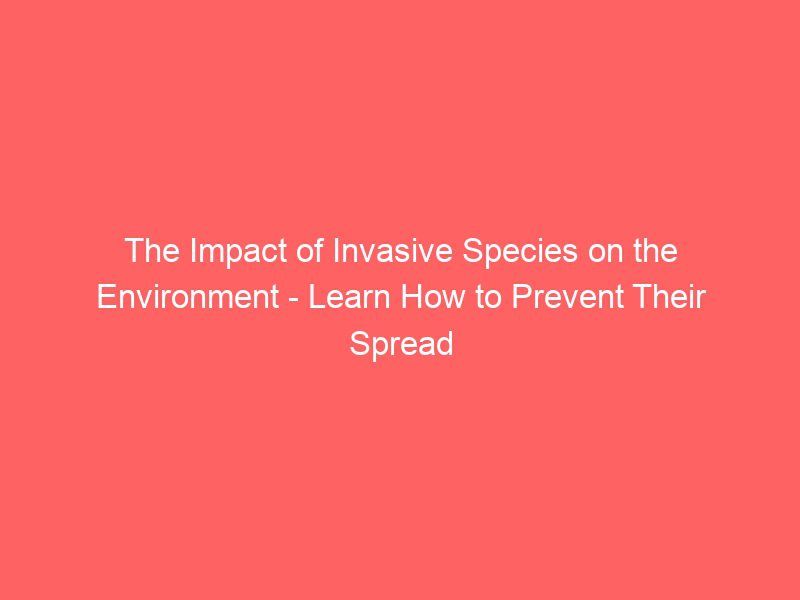Blog
The Impact of Invasive Species on the Environment – Learn How to Prevent Their Spread

“There are invasive species. You’ve probably heard the term, but what does it actually mean? How does it vary from phrases like non-native species or pests? …Is it related to a particular quantity of damage? Is it a species that has strayed from its natural habitat?”
Learn how native, non-native, and invasive species affect their surroundings, as well as how pests fit into the picture, with the help of this National Park Service video: What are invasive species?
Furthermore, how can you aid in the prevention of the introduction and spread of invasive species in our national parks and at home?
Before visiting the park, check the park’s website or the visitor center for current invasive species issues, and consider wearing short gaiters to prevent seed attachment to clothing. Cleaning boots and shoes, avoiding insect transportation in food and agricultural commodities, feeding weed-free feed to pack animals, and not carrying external firewood are all important safeguards.
Individuals should wash their vehicles after outdoor activities, shake out their camping gear, clean their pets if they have been in the park, and inspect their shoes and boots for dirt and plant items.
Following the “Clean, Drain, Dry” technique for boats and equipment, properly disposing of unwanted bait, and reporting invasive species discoveries on time all help to preserve the park’s environment.
Contribute to preventing the spread of invasive species within national parks and in your community: It is critical to practice responsible pet ownership, which includes not releasing pets into the wild or emptying aquariums into waterways.
Raise awareness about invasive species by detecting and eradicating them from your area using regional lists. Replace non-native species in your garden to support native plant advocacy. Local resources can offer assistance.
Additionally, support local produce to help decrease pest spread and prevent climate change.
The Impact of Invasive Species on the Environment
Invasive species can wreak havoc on ecosystems, posing a threat to native plants, animals and even human health. Let’s dive deeper into what invasive species are, the harm they can cause, and how we can prevent their spread.
Invasive species refer to plants and animals that are not native to a particular environment and can cause harm to the ecosystem they invade. These organisms have left their own habitat and found a new home where they disrupt the natural balance. They can outcompete native species for resources, disrupt food chains, and alter habitats. Invasive species have been introduced to various environments, including national parks and other protected areas.
When invasive species enter a new ecosystem, they often lack natural predators and competitors, allowing them to multiply rapidly and outcompete native species. This can result in a decline or even extinction of native plant and animal species, disrupting the delicate balance of the ecosystem. For example, the introduction of the white-footed mouse to non-native habitats can lead to a decline in native species and have far-reaching consequences for the ecosystem.
Invasive species pose threats beyond the natural ecosystem. They can harm the environment by degrading habitats, reducing biodiversity, and altering natural processes. Economically, invasive species can cause damage to crops, forests, and fisheries, resulting in financial losses. Furthermore, some invasive species can pose health risks to humans by spreading diseases or causing allergies. It’s crucial to address the impacts of invasive species to protect the environment, economy, and human well-being.
Let’s take a closer look at two examples of invasive species. The bell pepper, a non-native species, poses no threat to native plants in the United States. It is widely cultivated and has become a popular ingredient in many dishes. On the other hand, kudzu, an invasive vine introduced to the United States in 1876, poses a significant threat. It grows rapidly, covering plants and power lines, leading to damage and power outages in communities.
Preventing the Spread of Invasive Species
Prevention is key in managing invasive species. Whether you’re a hiker, camper, or nature enthusiast, you can play a role in preventing their spread. Avoid transporting firewood from one area to another, as it can harbor invasive insects. Clean your gear, including boats and hiking boots, to remove any potential hitchhikers. Educate yourself on local invasive species and report sightings to the appropriate authorities. By taking these steps, we can protect our ecosystems and preserve biodiversity.
Invasive species are a significant concern for the economy environment and human health. Their introduction and spread can have devastating consequences for native species, ecosystems and our well-being. It is crucial that we take proactive measures to prevent their spread and mitigate their impacts. Together, we can protect our natural heritage and ensure a sustainable future.







